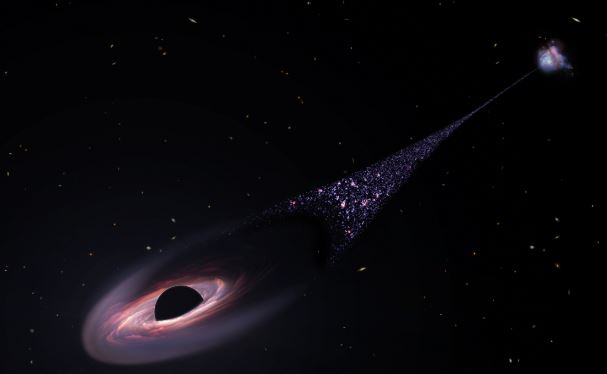New Delhi: A supermassive black hole, weighing as much as 20 million Suns, has left behind a 2,00,000-light-year-long condensed trail of newborn stars, twice the diameter of the Milky Way galaxy, in its wake, according to the National Aeronautics and Space Administration (NASA), US.
Captured accidentally by NASA’s Hubble Space Telescope, the black hole was seen racing through the intergalactic space so fast that, within our solar system, it could travel from Earth to the Moon in 14 minutes.
“We think we’re seeing a wake behind the black hole where the gas cools and is able to form stars. So, we’re looking at star formation trailing the black hole,” said Pieter van Dokkum of Yale University in New Haven, Connecticut, US.
“What we’re seeing is the aftermath. Like the wake behind a ship, we’re seeing the wake behind the black hole,” said van Dokkum.
The researchers have published their paper in The Astrophysical Journal Letters.
They said that the black hole lies at one end of the column, at the other end of which lies its parent galaxy. They think that the gas is being ‘shocked’ and heated from the motion of the black hole hitting the gas, or it could be radiation from an accretion disk around the black hole.
“This is pure serendipity that we stumbled across it,” van Dokkum added. He was looking for globular star clusters in a nearby dwarf galaxy.
“I was just scanning through the Hubble image and then I noticed that we have a little streak. I immediately thought, ‘oh, a cosmic ray hitting the camera detector and causing a linear imaging artifact.’ When we eliminated cosmic rays we realized it was still there. It didn’t look like anything we’ve seen before,” said van Dokkum.
Van Dokkum and his team followed up the sight with spectroscopy with the W. M. Keck Observatories in Hawaii. The star trail being “quite astonishing, very, very bright and very unusual” made them conclude that they were looking at the aftermath of a black hole flying through a halo of gas surrounding the host galaxy.
Astronomers suspect this phenomenon to likely be the result of multiple collisions of supermassive black holes, the first two having perhaps merged 50 million years ago. Brought together closer at their centres, they whirled around each other as a binary black hole, they said.
Then came another galaxy with its own supermassive black hole, mixing up the three to form a chaotic and an unstable configuration. One of the black holes robbed momentum from the other two black holes and got thrown out of the host galaxy, they said.
Following this, the remaining binary system of black holes shot off in the opposite direction, they said.
There is a feature seen on the opposite side of the host galaxy that might be the runaway binary black hole. Circumstantial evidence for this is that there is no sign of an active black hole remaining at the galaxy’s core, they said.
The next step, they said, would be to do follow-up observations with NASA’s James Webb Space Telescope and the Chandra X-ray Observatory to confirm the black hole explanation.
PTI
